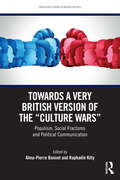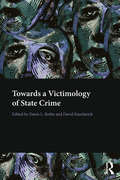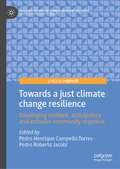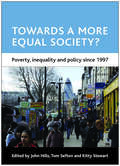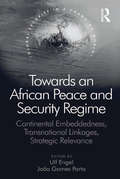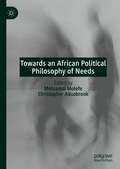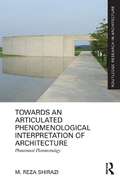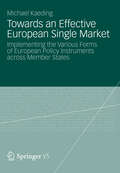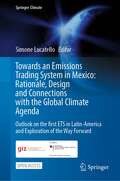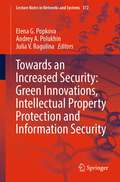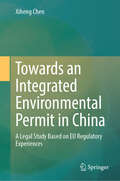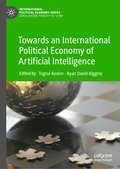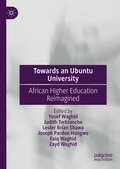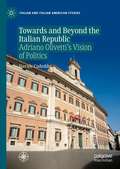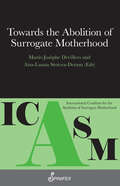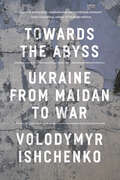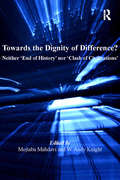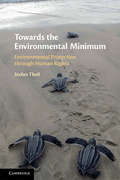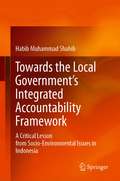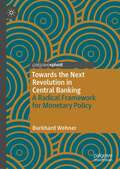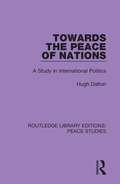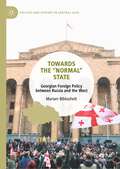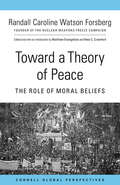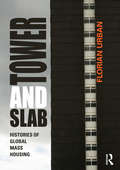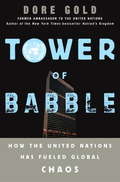- Table View
- List View
Towards a Very British Version of the “Culture Wars”: Populism, Social Fractures and Political Communication (Routledge Studies in British Politics)
by Alma-Pierre Bonnet Raphaële KiltyThis book examines the emergence and the political use of what has come to be known as “culture wars” in the United Kingdom.Adopting multidisciplinary perspectives, it investigates the ways in which cultural identities are used for political ends. The book bridges the conceptual and theoretical gap in fully understanding the so-called culture wars in a British context; as such, it envisages debates as part of a larger political project to gain popular support by tapping into voters’ sense of neglect by the political elite. Applying the concept of “national populism” as a binding conceptual framework for the book, a prestigious panel of international experts offer thorough analyses to show that not enough attention is being paid to what may be considered as an “escalation” of culture wars, and to how divisions have been accentuated by political elites to deliberately exacerbate them.This book will be of key interest to scholars, students and readers in British politics, populism studies, party politics, Conservative party politics and more broadly to European and Comparative politics.
Towards a Victimology of State Crime
by David Kauzlarich Dawn L. RotheMillions of people have been victimized by the actions and omissions of states and governments. This collection provides expert analyses of such victimizations across the world, from Europe, the United States, and Africa to New Zealand and South America. Leading scholars in the area of state crime describe the nature, extent, and distribution of state crime victimization, as well as theoretical and practical paths for understanding, explaining, and aiding victims of massive harms by governments. Cases of state crime and state victimization are presented on Brazilian, Native American, and New Zealand children, Somalian Pirates, Columbian, South African, and Bosnian civilians, United States immigrants, and war crime victimization in World War II. Other chapters delve into formal and informal ways to address victimization through the European Court of Human Rights, the International Criminal Court, and provide analyses of justice processes around the world. This anthology bridges the latest thinking, theory and research in the fields of state crime and victimology and provides a general resource concerning basic issues related to victimization - particularly victims of state crime. As such, it fills a major gap in the literature by providing the first text and scholarly book focused solely on a victimology of state crime. This book is essential reading for undergraduates, postgraduates, socio-legal jurists and academics with an interest in state crime and victimology.
Towards a just climate change resilience: Developing resilient, anticipatory and inclusive community response (Palgrave Studies in Climate Resilient Societies)
by Pedro Henrique Campello Torres Pedro Roberto JacobiThis book provides an accessible overview of how efforts to combat climate change and social inequalities should be tackled simultaneously. In the context of the climate emergency, the impacts of extreme events can already be felt around the world. The book centres on five case studies from the Global South, Latin America, Pacific Islands, Africa, and Asia with each one focused on climate justice, resilience, and community responses towards a just transition. The book will be an invaluable reference for advanced undergraduates and postgraduate students, researchers, policymakers, and practitioners in environmental studies, urban planning, geography, social science, international development, and disciplines that focus on the social dimensions of climate change.
Towards a more equal society?: Poverty, inequality and policy since 1997 (CASE Studies on Poverty, Place and Policy)
by John Hills, Tom Sefton and Kitty StewartWhen New Labour came to power in 1997, its leaders asked for it to be judged after ten years on its success in making Britain 'a more equal society'. As it approaches the end of an unprecedented third term in office, this book asks whether Britain has indeed moved in that direction. The highly successful earlier volume A more equal society? was described by Polly Toynbee as the LSE's mighty judgement on inequality. Now this second volume by the same team of authors provides an independent assessment of the success or otherwise of New Labour's policies over a longer period. It provides: · consideration by a range of expert authors of a broad set of indicators and policy areas affecting poverty, inequality and social exclusion; · analysis of developments up to the third term on areas including income inequality, education, employment, health inequalities, neighbourhoods, minority ethnic groups, children and older people; · an assessment of outcomes a decade on, asking whether policies stood up to the challenges, and whether successful strategies have been sustained or have run out of steam; chapters on migration, social attitudes, the devolved administrations, the new Equality and Human Rights Commission, and future pressures. The book is essential reading for academic and student audiences with an interest in contemporary social policy, as well as for all those seeking an objective account of Labour's achievements in power.
Towards an African Peace and Security Regime: Continental Embeddedness, Transnational Linkages, Strategic Relevance (Global Security in a Changing World)
by João Gomes PortoTowards an African Peace and Security Regime: Continental embeddedness, transnational linkages, strategic relevance provides an informed and critical reflection on the adequacy of the emerging African Peace and Security Architecture (APSA) to the medium- and long-term challenges and opportunities of conflict prevention, management and resolution in Africa. Complementary to the editors’ Africa’s New Peace and Security Architecture: Implementing norms, institutionalising solutions (Ashgate 2010), this volume revolves around three main areas of focus: the continental ’embeddedness’ of norms, values and processes required for the gradual coming into shape of the African peace and security regime; its transnational linkages as well as the wider collective security environment; and the empirical analysis of the connections between the continental level and the regional economic communities with case-studies on ECOWAS, SADC and COMESA.
Towards an African Political Philosophy of Needs
by Motsamai Molefe Christopher AllsobrookThis book focuses on the domains of moral philosophy, political philosophy, and political theory within African philosophy. At the heart of the volume is a call to imagine African political philosophy as embodying a needs-based political vision. While discourses in African political philosophy have fixated on the normative framework of human rights law to articulate demands for social and global justice, this book charts a new frontier in African political thought by turning from ‘rights’ to ‘needs.’ The authors aim to re-orient discourses in African philosophy beyond the impasse of rights-based confrontations to shift the conversation toward needs as a cornerstone of African political theory.
Towards an Articulated Phenomenological Interpretation of Architecture: Phenomenal Phenomenology (Routledge Research in Architecture)
by M. Reza ShiraziThis book sheds light on the contemporary status of phenomenological discourse in architecture and investigates its current scholastic as well as practical position. Starting with a concise introduction to the philosophical grounds of phenomenology from the points of view of Husserl, Merleau-Ponty and Heidegger, it presents a critical reading of the works of some leading figures of architectural phenomenology in both theory and practice, such as Christian Norberg-Schultz, Kenneth Frampton, Juhani Pallasmaa, and Steven Holl. Highlighting the main challenges of the current phenomenological discourse in architecture, this book formulates a more articulated method of 'phenomenological interpretation' – dubbed 'phenomenal phenomenology' − as a new and innovative method of interpreting the built environment. Finally, using Tadao Ando's Langen Foundation Museum as a case study, it investigates the architect's contribution to phenomenological discourse, interprets and analyzes the Museum building using the new heuristic method, and thus provides a clear example of its applicability. By introducing a clear, articulated, and practical method of interpretation, this book is of interest to academics and students analyzing and studying architecture and the built environment at various scales.
Towards an Effective European Single Market
by Michael KaedingIf the European Union and its Member States are to compete successfully in an increasingly aggressive global market, whilst many other economies continue to get stronger, all parts of the European Union, Member States and the EU institutions, have to regulate smarter. The answer therefore is not to give up on rules, but rather to develop and implement good quality rules. Presenting both timely and relevant forms of European policy instruments in the field of financial services, public administration, transport, working conditions and social protection, this volume shows which kind of policy instruments work and under what circumstances. This will help all to overcome many of the impediments to using alternative policy instruments at the European level as appropriate responses to pressing European and global governance challenges, such as efficiency, accountability, transparency and legitimacy.
Towards an Emissions Trading System in Mexico: Outlook on the first ETS in Latin-America and Exploration of the Way Forward (Springer Climate)
by Simone LucatelloThis Open Access book provides detailed information about the incoming Mexican Emissions Trading System, including an analysis on why the system was implemented, how the system was designed, how it operates, how it could work, and how it could be strengthened by 2023 when it will be formally launched. This document is aimed at those who want to understand how an ETS can operate in an emerging economy. Although it has been written for experts and non-experts, this book does not provide the underlying theory of market-based instruments and emissions trading systems in general. The book can be read from start to finish, but can also be used as a reference for specific components of regional ETSs. The book draws upon a meticulous study of background documents and fieldwork from different authors to tell the story of how a Mexican ETS, the first of its kind in Latin America, can be set in the country. The emissions trading system cover many greenhouse gas emissions and has been hailed as one of the cornerstones of the Mexican climate policy. The book also examines and explains how the ETS is designed and implemented.
Towards an Increased Security: Green Innovations, Intellectual Property Protection and Information Security (Lecture Notes in Networks and Systems #372)
by Elena G. Popkova Julia V. Ragulina Andrey A. PolukhinThis book aims to show that modern socio-economic and entrepreneurial systems are on the path to the increase of security and to determine the obstacles they face on this path, as well as determine the opportunities for overcoming these obstacles. The purpose of this book is to study new achievements in the sphere of the provision of security. The originality of this book consists in the development of the fundamental basis of the provision of modern socio-economic systems’ security through development and application of the new classification of the directions of provision of security—food and ecological, information and technological, and personnel and intellectual—and their systemic consideration.Five parts of this book elaborate on progressive green innovations in agriculture and the modern experience of food security provision; legal regulation of sustainable development and environmental security; economic security of regions and green innovations in natural resources management; technological security in the digital environment, data protection and information security; and security and the priority for personnel management and intellectual property protection.The target audience of this book are scholars, who will find in it the fundamental inventions and empirical studies of the international experience of security provision; representatives of public authorities, who will find in the book the recommendations on monitoring and regulation of food and ecological, information and technological, and personnel and intellectual security; and subjects of entrepreneurship, who will find in the book the applied solutions for corporate management of security.
Towards an Integrated Environmental Permit in China: A Legal Study Based on EU Regulatory Experiences
by Xiheng ChenThis book examines the extent to which the regulatory design of the emissions permit system in China, taking into account the EU's regulatory experience with integration and from the perspective of the specific Chinese situation, provides opportunities for or hinders the implementation of integrated pollution prevention and control. It was found that China's permitting system provides regulatory opportunities for integrated control of emissions to air, water, and land, but that some challenges remain, particularly in terms of environmental effectiveness and environmental trade-offs. This book is not only aimed at the academic community, but may also benefit policy makers by providing an explanation of the rationale for integrated environmental permitting, together with a critical reflection on the current state of emissions permitting in China. It may also be helpful to the ENGOs that focus on and are willing to comment on the choices of regulatory instruments to be made by the Chinese government, particularly in the light of achieving a high level of environmental protection as a whole.
Towards an International Political Economy of Artificial Intelligence (International Political Economy Series)
by Tugrul Keskin Ryan David KigginsThis volume seeks to leverage academic interdisciplinarity to develop insight into how Artificial intelligence (AI), the latest GPT to emerge, may influence or radically change socio-political norms, practices, and institutions. AI may best be understood as a predictive technology. “Prediction is the process of filling in missing information. Prediction takes information you have, often called ‘data’, and uses it to generate information you don’t have” (Agrawal, Gans, and Goldfarb 2018, 13; also see Mayer-Schonberger and Ramge 2018). AI makes prediction cheap because the cost of information is now close to zero. Cheap prediction through AI technologies are radically altering how we govern ourselves, interact with each other, and sustain society. Contributors to this volume represent the academic disciplines of Sociology and Political Science working within a diverse set of intra-disciplinary fields that when combined, yield novel insights into the following questions guiding this volume: How might AI transform people? How might AI transform socio-political practices? How might AI transform socio-political institutions?
Towards an Ubuntu University: African Higher Education Reimagined
by Yusef Waghid Faiq Waghid Zayd Waghid Judith Terblanche Lester Brian Shawa Joseph Pardon HungweThis book explores the argument to reconsider the idea of a university in light of the African ethic of ubuntu; literally, human dignity and interdependence. The book discusses, through the context of higher education discourse of philosophy and comparative education, how global universities have evolved into higher educational institutions concerned with knowledge (re)production for various end purposes that range from individual autonomy, to public accountability, to serving the interests of the economy and markets. The question can legitimately be asked: Is an ubuntu university different from an entrepreneurial university, thinking university, and ecological university? While these different understandings of a university accentuate both the epistemological and moral imperatives in relation to itself and the societies in which they manifest, it is through the ubuntu university that emotivism in the forms of dignity and humaneness will enhance a university’s capacity for autonomy, responsibility, and criticality. This book would be of academic interest to university educators and students in philosophy of education, comparative education, and cultural studies.
Towards and Beyond the Italian Republic: Adriano Olivetti’s Vision of Politics (Italian and Italian American Studies)
by Davide CadedduThis book examines the historical process that led to the foundation of the Italian Republic and its constitution, viewed through the personal experiences and political reflections of Adriano Olivetti (between 1919 and 1960), general manager and president of the well-known typewriter manufacturer “Ing. C. Olivetti & C.” An unbroken line of reasoning linked his maturing political reflections during the two post-war periods. The historical context of the 1950s did not prove to be very propitious, but the guidelines dispersed throughout the Italian cultural and political world from the movement that Olivetti founded were certainly seminal – generating a legacy of ideas that has only in part been recognized. What makes this study distinctive is the original approach to reading the history of Italy through Adriano Olivetti’s eyes and thoughts, far from the more common Christian Democratic or Communist perspective of those years. It is simply another view of what the Italian Republic could be and was not.
Towards the Abolition of Surrogate Motherhood
by Marie-Josèphe Devillers, Ana-Luana Stoicea DeramSurrogacy is not liberty. It is a crime. Women will not settle for junk liberty.We want real freedom – the substance, not just the appearance. We want real nourishment for our spirits. We want human dignity. We want it for all of us. We want it for women in Thailand and Bangladesh and Mexico as well as for the women who have not yet been born.—Gena CoreaIn this eloquent and blistering rejection of surrogacy, a range of international activists and experts in the field outline the fundamental human rights abuses that occur when surrogacy is legalised and reject neoliberal notions that the commodification of women's bodies can ever be about the ‘choices' women make.They outline a range of harms that follow – to the women who are so-called surrogates, to the children born of surrogacy arrangements, to the ‘intending parents' who a delivered of a child through forced separation from its mother.Catherine Lynch rails against surrogacy as the creation of babies for the express purpose of removal from their mothers, outlining the tragic outcomes for adopted people. Phyllis Chesler argues that commercial surrogacy is matricidal, “slicing and dicing biological motherhood” into egg donor, ‘gestational' mother and adoptive mother. Laura Nuño Gómez describes the surrogacy paradigm as an ethics-free zone, in which “buying whatever is for sale is possible as long as there is an agreement and that it is legal.” And Melissa Farley debunks the myth of ‘choice' in surrogacy, arguing that in a male-dominated and racist system, the exploitative sale of women in surrogacy, like in prostitution, is inherently harmful. Rich women do not make the choice to become surrogates or prostitutes.Other contributors to this collection include Renate Klein, Gary Powell, Marie-Josèphe Devillers, Rita Banerji, Laura Isabel Gomez Garcia, Eva Maria Bachinger, Alexandra Clement-Saby and Taina Bien Aimé.Harm cannot be regulated, because this would mean spreading and universalising it
Towards the Abyss: Ukraine from Maidan to War
by Volodymyr Ishchenko"Nuanced, melancholy, sophisticated and gratifyingly intimate."–Yanis Varoufakis, author of TechnofeudalismUkrainian politics, the Russian invasion and the escalating crisis of the post-Soviet worldTowards the Abyss presents searching analysis of a decade of war and upheaval in Ukraine. Volodymyr Ishchenko has been among the left&’s most significant commentators on Ukraine since 2014, when pro-EU protestors toppled the government in Kiev, Russia annexed Crimea and pro-Russian separatists seized parts of the Donbass. One of his first thoughts when he read the news of the full-scale Russian invasion on 24 February 2022 was that no matter how the war ends, he will no longer have a homeland.What has happened in Ukraine ever since the Soviet collapse is a drawn-out process of de-modernization, and the downward spiral is getting faster. Ishchenko argues that the conflict being fought in Ukraine with tanks, artillery and rockets is the same conflict suppressed by police batons in Belarus and in Russia itself. The intensification of the post-Soviet crisis – the incapacity of an oligarchic ruling class in the territories of the former USSR to sustain political or moral leadership – is the root cause of the escalating violence.
Towards the Dignity of Difference?: Neither 'End of History' nor 'Clash of Civilizations' (Ethics and Global Politics)
by Mojtaba MahdaviThe rise of popular social movements throughout the Middle East, North Africa, Europe and North America in 2011 challenged two hegemonic discourses of the post-Cold War era: Francis Fukuyama's 'The End of History' and Samuel Huntington's 'The Clash of Civilizations.' The quest for genuine democracy and social justice and the backlash against the neoliberal order is a common theme in the global mass protests in the West and the East. This is no less than a discursive paradigm shift, a new beginning to the history, a move towards new alternatives to the status quo. This book is about difference and dialogue; it embraces The Dignity of Difference and promotes dialogue. However, it also demonstrates the limits of dialogue as a useful and universal approach for resolving conflicts, particularly in cases involving asymmetric and unequal power relations. The distinguished group of authors suggests in this volume that there is a 'third way' of addressing global tensions - one that rejects the extremes of both universalism and particularism. This third way is a radical call for an epistemic shift in our understanding of 'us-other' and 'good-evil', a radical approach toward accommodating difference as well as embracing the plural concept of 'the good'. The authors strengthen their alternative approach with a practical policy guide, by challenging existing policies that either exclude or assimilate other cultures, that wage the constructed 'global war on terror,' and that impose a western neo-liberal discourse on non-western societies. This important book will be essential reading for all those studying civilizations, globalization, foreign policy, peace and security studies, multiculturalism and ethnicity, regionalism, global governance and international political economy.
Towards the Environmental Minimum: Environmental Protection through Human Rights
by Stefan TheilPervasive environmental harm that disproportionately impacts vulnerable members of society is left largely unregulated across the globe despite existing legal commitments to human rights and environmental protection in many states. To address this shortcoming, Stefan Theil proposes a new normative framework for environmental protection through human rights law. In clear and accessible prose, he demonstrates how such a human rights-based approach can strengthen environmental protection without requiring radical departures from established protection regimes and legal principles. The environmental minimum developed in the book translates the general and abstract commitments of states into specific and practical measures that protect the environment. The framework develops the doctrine of international, regional, and domestic courts, analysed through an innovative approach that improves contextual awareness. This book is thus a valuable resource for lawyers, social scientists, political theorists, environmental and human rights advocates.
Towards the Local Government’s Integrated Accountability Framework: A Critical Lesson from Socio-Environmental Issues in Indonesia
by Habib Muhammad ShahibThis book shows the growing phenomenon and the broad impact of socio-environmental conflicts in the grassroots communities—farmers, fishermen and urban poor—in Indonesia, as the effects of government’s development strategies based on neoliberal and New Public Management (NPM) views without a clear accountability system or socio-environmental accountability practices and reports are becoming apparent. Inspired by the emancipatory socio-environmental accounting discourse, which focuses on the socio-local context in developing alternative models of accountability based on local views and people's aspirations, this book uses research methodology based on the principles put forth by Indonesian national hero and critical scholar Tan Malaka to develop a framework of integrated accountability for the local government. This book fills the present gap in English publications that analyse the intents and outcomes of the public management reforms in Indonesia with regard to socio-environmental issues, as a basis for further research at the international level as well as policymaking in Indonesia. As the Indonesian government has recently undertaken key structural and accounting reforms in the public sector, this book is a timely and valuable read for graduate students, researchers,- and policymakers.
Towards the Next Revolution in Central Banking: A Radical Framework for Monetary Policy
by Burkhard WehnerThis book critically explores past and present principles of central banking, and outlines a new framework for future stabilization policy. Through compact and concise chapters, it demonstrates why a constant long-term interest rate would be the most beneficial target for monetary policy to follow. A novel set of policy tools and institutional arrangements suitable to reliably meet this target are developed.It is argued that the proposed framework would be clearly superior to conventional policies in preventing financial market crises, maintaining high employment, and keeping the economy at or near potential. The merits and shortcomings of alternative theories such as Modern Monetary Theory are also discussed.This book will be relevant to researchers and policymakers as well as professional investors, analysts, and commentators of financial markets and the economy at large.
Towards the Peace of Nations: A Study in International Politics (Routledge Library Editions: Peace Studies)
by Hugh DaltonHugh Dalton was a British Labour Party economist and politician, who served as Chancellor of the Exchequer from 1945 to 1947 under Clement Atlee. After surviving the First World War, he was drawn in to active politics with the belief that, rightly handled, it could put an end to war. This title, originally published in 1928, is based on his journeys of political observation in Europe, where he examined the new conditions created by the war and subsequent events. He outlines some central problems and some provisional solutions.
Towards the “Normal” State: Georgian Foreign Policy between Russia and the West (Politics and History in Central Asia)
by Mariam BibilashviliThis book explores the dilemmas of Georgian foreign policy since independence in 1991. Since the collapse of the Soviet Union, Georgia—a Caucasian republic with a fiercely independent national identity—has sought its own special path to European modernity, a promised land of prosperity and peace. Foreign policy has sought to reconcile the dream of European identity with the reality of being a small, post-colonial nation that was governed from Russia for nearly two centuries and remains mired in border conflicts with Russia. In an era when Russian concerns about sovereignty are once again dominating geopolitics, this book interests historians, scholars of imperialism, and scholars of the former Soviet Union and its messy politics.
Toward a Theory of Peace: The Role of Moral Beliefs
by Randall Caroline ForsbergMilitary analyst, peace activist, teacher, and social theorist Randall Caroline Watson Forsberg (1943–2007) founded the Nuclear Freeze campaign and the Institute for Defense and Disarmament Studies. In "Toward a Theory of Peace," completed in 1997 and published for the first time here, she delves into a vast literature in psychology, anthropology, archeology, sociology, and history to examine the ways in which changing moral beliefs came to stigmatize forms of "socially sanctioned violence" such as human sacrifice, cannibalism, and slavery, eventually rendering them unacceptable. Could the same process work for war?Edited and with an introduction by political scientists Matthew Evangelista (Cornell University) and Neta C. Crawford (Boston University), both of whom worked with Forsberg.
Tower and Slab: Histories of Global Mass Housing
by Florian UrbanTower and Slab looks at the contradictory history of the modernist mass housing block - home to millions of city dwellers around the world. Few urban forms have roused as much controversy. While in the United States decades-long criticism caused the demolition of most mass housing projects for the poor, in the booming metropolises of Shanghai and Mumbai remarkably similar developments are being built for the wealthy middle class. While on the surface the modernist apartment block appears universal, it is in fact diverse in its significance and connotations as its many different cultural contexts. Florian Urban studies the history of mass housing in seven narratives: Chicago, Paris, Berlin, Brasilia, Mumbai, Moscow, and Shanghai. Investigating the complex interactions between city planning and social history, Tower and Slab shows how the modernist vision to house the masses in serial blocks succeeded in certain contexts and failed in others. Success and failure, in this respect, refers not only to the original goals – to solve the housing crisis and provide modern standards for the entire society – but equally to changing significance of the housing blocks within the respective societies and their perception by architects, politicians, and inhabitants. These differences show that design is not to blame for mass housing’s mixed record of success. The comparison of the apparently similar projects suggests that triumph or disaster does not depend on a single variable but rather on a complex formula that includes not only form, but also social composition, location within the city, effective maintenance, and a variety of cultural, social, and political factors.
Tower of Babble
by Dore GoldA United Nations insider exposes how anti-American and antidemocratic forces have hijacked the UN and put America and its allies at risk Politicians and pundits are imploring the United States to give the UN a major role in American foreign policy. But as bestselling author Dore Gold reveals in Tower of Babble, it is absurd to look to the UN to fight aggression, combat terrorism, and preserve global order. The UN is an abject failure--a fatally flawed organization that has actually accelerated and spread global chaos. And it is dominated by anti-Western forces, dictatorships, state sponsors of terrorism, and America's worst enemies.In his New York Times bestseller Hatred's Kingdom, Gold blew the lid off Saudi support for terrorism, and now he uncovers an even more important story. As a former UN ambassador, he has a unique insider's perspective on why the UN fails to address--or in many cases exacerbates--the very problems it was created to solve. He shows how President Franklin Roosevelt's great vision has been corrupted beyond recognition. Using internal UN documents and classified cables, Gold presents stark evidence of how the UN ignores mass murder, emboldens terrorists, props up dictators, and otherwise betrays its mission to protect the world's security. Tower of Babble reveals:* Why America can--and indeed must--go outside the UN to address the most serious threats to national security* How the UN jeopardizes the success of the war on terror--and how terrorist groups have actually penetrated UN organizations* How, in the space of a year, the UN turned a blind eye to two horrifying episodes of mass murder--and why the slaughters could have been prevented* How the oil-for-food scandal only hints at the UN's repeated failures to deal with Saddam Hussein's Iraq* How the UN's new international criminal court threatens America's sovereignty* How the UN's startling record of failure has led Presidents Truman, Kennedy, Johnson, Clinton, and George W. Bush to bypass the UN Security CouncilAs this hard-hitting book reveals, it is, quite simply, a myth that the United Nations is a positive force for world order or the "sole source of international legitimacy." And unless the United States and its allies recognize this now, they will continue to put themselves at risk."Dore Gold's book is informed and informative. It can be read with pleasure and profit by anyone with a genuine interest in the United Nations. I warmly recommend it."--Jeane J. Kirkpatrick, former Ambassador to the United Nations"For anyone wondering what's wrong with the United Nations, this is the book to read. Providing both a concise history and an urgent warning for our own time, Dore Gold in clear and lively detail explains how and why the UN too often promotes not peace, but problems--and what we can do about it."--Claudia Rosett, columnist, the Wall Street Journal's Opinionjournal.com"Dore Gold's Tower of Babble is bound to be one of the most controversial critiques in the public debate on the UN."--Henry Kissinger, Former Secretary of StateFrom the Hardcover edition.
